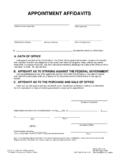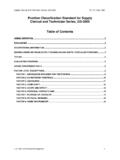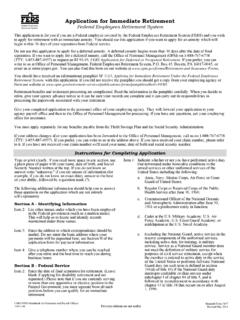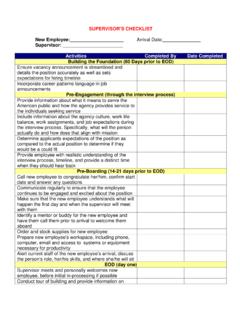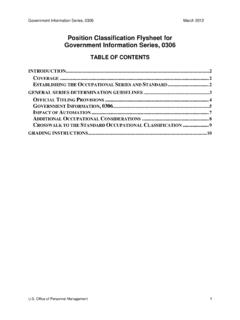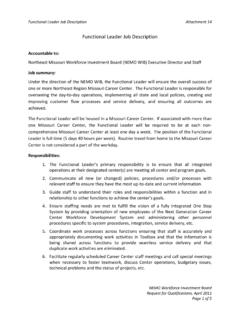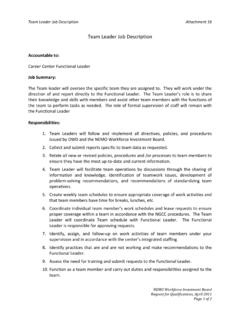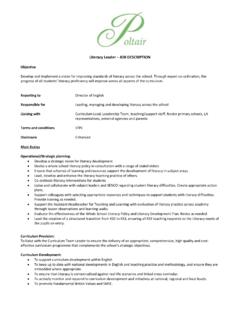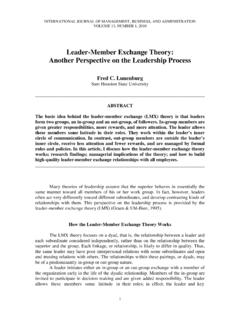Transcription of General Schedule Leader Grade Evaluation Guide - …
1 General Schedule Leader Grade Evaluation Guide HRCD-5 June 1998 General Schedule Leader Grade Evaluation Guide TABLE OF CONTENTS PART I - General Schedule WORK Leader COVERAGE OF PART NOTE TO Grade LEVEL TITLING SERIES PART II - General Schedule TEAM Leader COVERAGE OF PART NOTE TO Relationship to Bargaining Unit Status of Team Leader OCCUPATIONAL Functions of Team Differences Between Team leaders and Grade LEVEL Base Level of Work TITLING SERIES Office of Personnel Management 1 General Schedule Leader Grade Evaluation Guide HRCD-5 June 1998 PART I - General Schedule WORK Leader POSITIONS GUIDANCE FOR CLASSIFICATION OF ONE- Grade INTERVAL General Schedule WORK Leader POSITIONS COVERAGE OF PART I Part I of this Guide is used to classify positions of work leaders who, as a regular and recurring part of their assignment, lead three or more employees in clerical or other one- Grade interval occupations in the General Schedule in accomplishing work.
2 Work leaders also perform work that is usually of the same kind and level as that done by the team lead. Part I of this Guide supersedes the Work Leader Grade Evaluation Guide issued in January 1976. leaders are responsible to their supervisors for ensuring that the work assignments of the other employees of the team are carried out by performing a range of duties such as: 1. Distribute and balance the workload among employees in accordance with established work flow or job specialization, assure timely accomplishment of the assigned workload, and assure that each employee has enough work to keep busy; 2. Keep in touch with the status and progress of work, and make day- to- day adjustments in accordance with established priorities, obtaining assistance from the supervisor on problems that may arise, such as backlogs which cannot be disposed of promptly; 3. Estimate and report on expected time of completion of work, and maintain records of work accomplishments and time expended and prepare production reports as requested; 4.
3 Instruct employees in specific tasks and job techniques and make available written instructions, reference materials and supplies; 5. Give on the job training to new employees in accordance with established procedures and practices; 6. Maintain a current knowledge and answer questions of other employees on procedures, policies, directives, etc. and obtain needed information or decisions from supervisor on problems that come up; 7. Check on work in progress or spot check work not requiring review (e. g., filing or direct services) and review completed work to see that supervisor's instruction on work sequence, procedures, methods and deadlines have been met; Office of Personnel Management 2 General Schedule Leader Grade Evaluation Guide HRCD-5 June 1998 8. Amend or reject work not meeting established standards, refer to supervisor questions or matters not covered by standards and problems in meeting performance standards; 9.
4 Monitor working conditions such as seating, ventilation, lighting, safety, etc.; 10. Approve leave for a few hours or for emergencies; 11. Inform employees of available services and employee activities; 12. Resolve simple, informal complaints of employees and refer others to supervisor; 13. Report to supervisor on performance, progress and training needs of employees, and on behavior problems; and 14. Provide information to supervisor as requested concerning promotions, reassignment, recognition of outstanding performance, and personnel needs. EXCLUSIONS Part I of this Guide should not be used for positions of: 1. Employees who are accountable as supervisors for planning, scheduling, and directing work operations, administering supervisory personnel functions, evaluating work performance, and taking necessary action to assure that the work of subordinate employees meets standards of quantity and quality. (See General Schedule Supervisory Guide , the Introduction to the Position Classification Standards, and Part II of this Guide .)
5 2. Employees who have "project" responsibility but do not lead other workers. In some work situations, employees are responsible for projects where some of the work needed to complete the projects is done (" farmed- out") by other employees. Where the other employees do such work under the immediate direction of their regular supervisors, the position of the employee with "project" responsibility is considered to be nonsupervisory in nature. 3. Employees who are responsible for work assignments requiring only one or two other workers. The positions of such employees have as their primary responsibility personal work accomplishment. Responsibility for work assignments involving one or two other persons is not sufficient to warrant being classified as a Leader . Such positions are classified under appropriate nonsupervisory classification standards. 4. Employees who lead two- Grade interval work or work accomplished by GS-09 or higher one- Grade interval positions.
6 Such positions are to be classified through application of Grade level criteria in Part II of this Guide . Office of Personnel Management 3 General Schedule Leader Grade Evaluation Guide HRCD-5 June 1998 NOTE TO USERS It is the nature of responsibility for the work of others, rather than the number of employees involved, that distinguishes between Leader and supervisory jobs. However, where the number of workers is more than 12, the position should be carefully reviewed to determine whether it is really that of a Leader rather than that of a supervisor, and therefore covered by this Guide for leaders of clerical and other one- Grade interval occupations. Grade LEVEL DETERMINATION Under Part I of this Guide , Leader positions are classified one GS Grade above the highest level of nonsupervisory work led. Neither the number of workers led nor the variety of occupations in which they perform work impact the Grade of a Leader position.
7 Because of the limited nature of Leader responsibility, these factors do not significantly affect the difficulty and responsibility involved in performing the duties of a Leader . Thus, where the employees in the team perform work in a variety of occupations, an extra Grade should not be added because of that variety to the level of nonsupervisory work used in classifying the Leader position. In determining the base level of work led, the Grade to be used usually is the Grade of the highest level employee in the team (other than the Leader or a supervisor). However, care should be taken to assure that this Grade reflects the level of the nonsupervisory work actually led. For example: a. The grades of employees assigned to a work team may reflect the level of their other work assignments rather than the work they do when they serve as members of the work team. b. The highest level employee assigned to the team may do work in an occupation in which the Leader is not fully qualified.
8 The level of such work should be used to Grade the Leader job only where the Leader , although not fully qualified, has enough knowledge of the occupation to lead the work involved (for example, pass on instructions from the supervisor, explain work methods, check work, and report to the supervisor on work status or causes of work delays). c. The highest level employee, although assigned to the team, may receive little or no leadership from the Leader in performing his work (for example, where the employee is an "expert" in the work, or performs above the normal full performance level of the occupation). In this case, the Grade of the highest level employee does not reflect the level of the nonsupervisory work actually led, and should not be used as the base level. Thus, in classifying one- Grade interval Leader jobs, consider only work where the Leader performs substantially the full range of Leader duties described under Coverage of Part I.
9 Office of Personnel Management 4 General Schedule Leader Grade Evaluation Guide HRCD-5 June 1998 Where the nonsupervisory work personally done by a Leader is at a higher Grade than the work done by the employees led, the nonsupervisory work and the Leader duties are graded separately. The final Grade of such a position is then determined by selecting the Leader Grade level or the nonsupervisory Grade level, whichever is higher. (Note: Where the final Grade of such a position is based on its nonsupervisory work, the position is titled and classified as a nonsupervisory position, not as a Leader .) TITLING INSTRUCTIONS Positions covered by Part I of this Guide are identified by prefixing the word "Lead" to the title of the position in which the Leader is qualified and which reflects the work being performed by those led: for example - LEAD SUPPLY CLERK LEAD VOUCHER EXAMINER LEAD MECHANICAL ENGINEERING TECHNICIAN SERIES DETERMINATION This Guide is not intended to affect current practice regarding series classification.
10 Positions classified as to Grade by means of this Guide will continue to be classified to the most appropriate classification series in accordance with definitions published in the Office of Personnel Management's (OPM) Handbook of Occupational Groups and Families and amplifying material in individual OPM position classification standards and guides. Office of Personnel Management 5 General Schedule Leader Grade Evaluation Guide HRCD-5 June 1998 PART II - General Schedule TEAM Leader POSITIONS GUIDANCE FOR CLASSIFICATION OF TWO- Grade INTERVAL General Schedule TEAM Leader POSITIONS COVERAGE OF PART II Part II of this Guide is used to classify positions whose primary purpose is, as a regular and recurring part of their assignment and at least 25% of their duty time, to lead a team of other General Schedule (GS) employees in accomplishing two- Grade interval work that meets at least the minimum requirements of Part II. Team leaders usually also participate in the work of the team by performing work that is of the same kind and level as the highest level of work accomplished by the team led.

